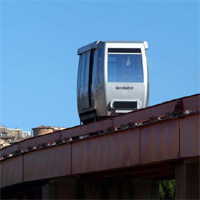Management of Touristic Flows with Innovative Transport Systems: Perugia Example
Abstract
Starting from 70’s, the City of Perugia has combined a high level of tourism attractiveness, due to thousands of years old environmental and cultural heritage, with a very innovative and sustainable approach to tackling urban mobility issues. The idea to create car parks all around the historic centre connected to the acropolis by mechanized routes (escalators and elevators), as the quickest way to get to final destinations in the most attractive areas of the City, has been recently enlarged and still further developed thanks to the realization of the metroline “Minimetro”, an innovative with a very low environmental impact mean of transport, that links in only 12 minutes the suburban area of Pian di Massiano, equipped with around 2.800 parking spaces, to the city centre, serving several urban districts with a less than one minute trip frequency. Minimetro transport system, nowadays a strong urban public transport corridor, suggested to plan and carry out new strategies to manage touristic flows, becoming the main mode of transport to access the city centre, both for small informal groups of tourists and for big organized ones, carried by coach. The tourist flows management arisen from this transport system is a breakthrough in the implementation of a city management strategy able to combine tourism attractiveness, economic growth, cultural heritage preservation and improvements in the quality of life for citizens. The use of Minimetro transport system for managing tourist flows offers many social and environmental advantages as a cut of 50% of pollutant emissions and waste of energy; moreover, the Minimetro system is becoming itself a “local monument”, boosting the tourism in the city of Perugia and promoting the enhancement and the increase in value of the areas served by the system; more and more, the Minimetro stations are going to turn into “stopping places” of urban cycle and pedestrian paths, increasing the potential of soft mobility in the city. Future scenarios in urban mobility management, with special reference to tourist coaches that arrive to Perugia, will be characterized by a technology enablement allowing a better monitoring control of focused city areas. The high-tech tools will make it possible to exclude unauthorized road users and to manage exceptions, enabling for the access vehicles that meet all the requirements. On this point, the Municipality of Perugia, as coordinator of a partnership composed of Italian Local authorities, has been awarded a grant from Elisa III (a programme financed by Presidency of Council of Ministers – Regional Affairs Department), for a submitted project entitled "Concerto". The "Concerto" project approaches the tourist flows management from a very innovative point of view, introducing concepts as accreditation, info-mobility and control of the accesses linked to geo-referenced services provision.Downloads
References
Comune di Perugia (1985) “Mobilità e relative infrastrutture – vol. 2 – parcheggi, scale mobili e ascensori, viabilità”.
Comune di Perugia – Servizi tecnologici ed energetici (1998) “Percorsi pedonali meccanizzati: dati tecnici e di esercizio”.
DEFRA (2007) “Passenger transport emissions factors: Methodology paper”, www.defra.gov.uk/environment/ business/envrp/pdf/passenger-transport.pdf.
F.M. Ciuffini, M. Goretti, L. Naldini (2008)”Sostenibilità ambientale ed energetica del Minimetrò di Perugia”, Atti 8° Congresso Nazionale CIRIAF.
Regione Umbria Osservatorio Regionale sul Turismo (2005- 2009) “Movimento turistico rilevato in Umbria”.
Regione Umbria Osservatorio Regionale sul Turismo (2009) “Rapporto annuale”.
Regione Umbria Osservatorio Regionale sul Turismo (2008) “L’impatto economico del Turismo” a cura di ISNART Istituto Nazionale Ricerche Turistiche.
“Dalla ricostruzione al futuro: architetture e infrastrutture in Umbria” (2007) ,Casabella n. 9.
“Minimetro: la scommessa del trasporto pubblico alternativo” (2008), Mobility Lab n. 20.

Copyright (c) 2014 Tema. Journal of Land Use, Mobility and Environment

This work is licensed under a Creative Commons Attribution 4.0 International License.
Authors who publish in this journal agree to the following:
1. Authors retain the rights to their work and give in to the journal the right of first publication of the work simultaneously licensed under a Creative Commons License - Attribution that allows others to share the work indicating the authorship and the initial publication in this journal.
2. Authors can adhere to other agreements of non-exclusive license for the distribution of the published version of the work (ex. To deposit it in an institutional repository or to publish it in a monography), provided to indicate that the document was first published in this journal.
3. Authors can distribute their work online (ex. In institutional repositories or in their website) prior to and during the submission process, as it can lead to productive exchanges and it can increase the quotations of the published work (See The Effect of Open Access)
